by Bruce Wells | Oct 31, 2023 | Petroleum Art
The use of energy resources has defined modern civilization. Museums, and historians, writers, and educators have preserved the heritage of the petroleum industry since the first U.S. well of 1859. Oilfield artists of all media remain important recorders and interpreters of petroleum’s worldwide influence.
For oil patch students and researchers, the American Oil & Gas Historical Society created the work-in-progress Oil in Art articles, to accompany the forums and resources page, which includes links for photography sources (especially universities and the Library of Congress), petroleum history videos, and a small AOGHS selection of books and authors.
(more…)
by Bruce Wells | Oct 23, 2023 | Petroleum Art
Company town baseball players sometimes made it to the Big Leagues — and the Hall of Fame.
The first pitcher ever inducted into the Baseball Hall of Fame, Walter “The Big Train” Johnson, worked in California oilfields as a teenager, beginning his famed career on an oil company town baseball team.
As baseball became America’s favorite pastime in the early 20th century, booming oil patch towns nationwide fielded teams with names that reflected their communities’ enthusiasm, and often their livelihood.
Company Town Baseball
In Texas, the booming petroleum town of Corsicana fielded the Oil Citys — and made baseball history in 1902 with a 51 to 3 drubbing of the Texarkana Casketmakers. Oil Citys catcher Jay Justin Clarke hit eight home runs in eight at bats during the game, still an unbroken baseball record.
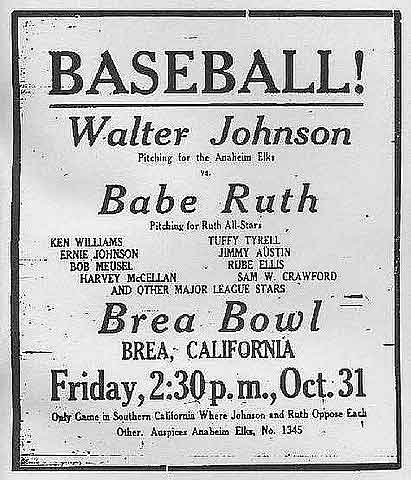
The former pitcher for the Olinda Oil Wells — Walter “The Big Train” Johnson — joined “Babe” Ruth in a 1924 exhibition game. Johnson would be one of the first five players inducted into the Baseball Hall of Fame in 1936.
In 1922, the Wichita Falls minor league team lost its opportunity for a 25th consecutive victory when the league determined the team had “doctored the baseball.” The Wichita Falls ballpark caught fire in June — during a game — and burned to the ground. It was a memorable season.
In Oklahoma oilfields, the Okmulgee Drillers for the first time in baseball history had two players who combined to hit 100 home runs in a single season of 160 games. First baseman Wilbur “Country” Davis and center fielder Cecil “Stormy” Davis accomplished their home run record in 1924, although their team faded away by 1927.

The Double-A team Tulsa Drillers began in 1977 when the Lafayette Drillers moved to Tulsa.
The Tulsa Oilers were the strongest team in the Western League for a decade, winning the pennant in 1920, ‘22, ‘27, ‘28 and ‘29. The name has continued in the hockey league’s Tulsa Oilers.

The Tulsa Drillers baseball team, a AA affiliate for the Major League, arrived in Tulsa from Lafayette, Louisiana, in 1977.
In baseball’s first official night game, the Producers, a company town baseball team in Independence, Kansas, lost to Muskogee Chiefs 13 to 3 on April 28, 1930. The game played under portable lights supplied by the Negro National League’s famed Kansas City Monarchs.

Hundreds of wells once pumped oil around the Olinda Oil Museum and Trail near Brea, California.
The Independence Producers were one of the 96 teams in the National Association of Professional Baseball Leagues, later known as Minor League Baseball.
Iola Gasbags and Borger Gassers
Thanks to mid-continent oil and natural gas discoveries, in just nine years beginning in 1895, Iola, Kansas, grew from a town of 1,567 to a city of more than 11,000. Gas wells lighted the way.
However, the Iola Gasbags reportedly adopted their team name not for the resource, but after becoming known as braggers in the Missouri State League.
“They traveled to these other cities, and they’d be bragging that they were the champions, so people started giving them the nickname Gasbags,” reported baseball historian Tim Hagerty in a July 2012 National Public Radio interview.
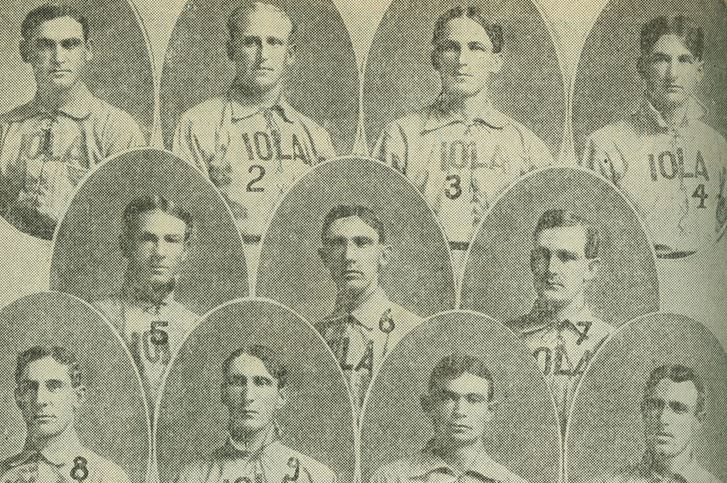
A natural gas boom in Kansas led to a baseball team being named the Iola Gasbags, pictured here in 1904. Photo courtesy National Baseball Hall of Fame Library.
In 1903, the players renamed themselves the Iola Gaslighters — but had a change of heart and reverted to the original name the following season.
“They said, ‘You know what? Yeah, we are, We’re the Gasbags.'” added Hagerty, author of Root for the Home Team: Minor League Baseball’s Most Off-the-Wall Names and the Stories Behind Them. “I think the state of Kansas may take the prize for the most terrific names — the Wichita Wingnuts, the Wichita Izzies, the Hutchinson Salt Packers…and the Iola Gasbags.”

In the Texas Panhandle, the petroleum-related town baseball team Borger Gassers disappeared after the 1955 season, despite Gordon Nell hitting a record-setting 49 homers in 1947. Team owners blamed television and air-conditioning for reducing minor league baseball attendance and profitability.
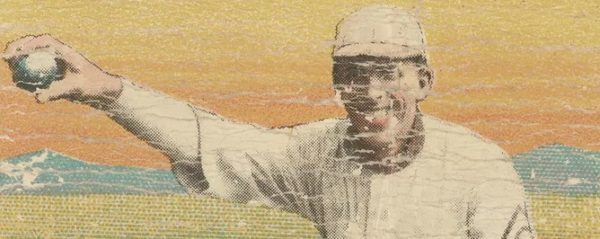
Detail from 1909 baseball card featuring Pacific Coast League pitcher Jimmy Wiggs. Image courtesy Library of Congress.
In Beaumont, Texas, site of the great Spindletop oil discovery of 1901, minor league baseball lasted for decades under several names. The first team, the Beaumont Oil Gushers of the South Texas League, was fielded in 1903. By the 1904 season the team was known as the Millionaires and then the Oilers before becoming the Beaumont Exporters in 1920.
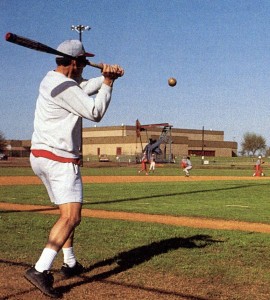
East of Dallas, in Van, Texas, fielding practice at the oil town baseball high school includes a reminder of a prolific oilfield discovered in 1929. Photo by Bruce Wells.
Although many thought the name should be changed to the Refiners, reflecting the city’s industry, for the 1950 season the team was briefly known as the Roughnecks (a former company town baseball team name still popular).
Beaumont’s last AA Texas League team was the Golden Gators, which folded in 1986. Another team in the Texas League, the company town baseball team Shreveport Gassers, on May 8, 1918, played 20 innings against the Fort Worth Panthers before the game was finally declared a tie at one to one.
Walter Johnson pitches for Olinda Oil Wells
Perhaps baseball’s greatest product from the oilfield was a young man who was a roustabout in the small oil town of Olinda, California. Walter Johnson (1887-1946) would earn national renown as the greatest pitcher of his time. His fastball was legendary.
In 1894, the Union Oil Company of Santa Paula purchased 1,200 acres in northern Orange County for oil development. Four years later the first oil well, Olinda No. 1, came in and created the oil boom town. Soon, the Olinda baseball players began making a name for themselves among the semi-pro teams of the Los Angeles area.

A 1961 baseball card notes headline of the former California oilfield roustabout’s amazing 1913 pitching record, which lasted until Don Drysdale pitched 58 scoreless innings in 1968.
By 1903, the Orange County team was sharing newly built Athletic Park in Anaheim, “two hours south of Olinda by horse and buggy,” noted one historian. Youngster Walter Johnson rooted for the local team, the Oil Wells.
Johnson, originally from Humboldt, Kansas, moved to the thriving oil town east of Brea with his family when he was 14. He attended Fullerton Union High School and played baseball there while working in the nearby oilfields. His high school pitching began making headlines, including a 15-inning game against rival Santa Ana High School in 1905 where he struck out 27.
Today, tourists visit the Olinda Oil Museum and Trail. This historic Orange County site includes Olinda Oil Well No. 1 of 1898, the oil company field office and a jack-line pump building.

By 17, Johnson was playing for his oil town baseball team, the Olinda Oil Wells, as its ace pitcher. He shared in each game’s income of $25, according to Henry Thomas in Walter Johnson: Baseball’s Big Train.
“Not a bad split for nine players considering that a roustabout in the oilfields started at $1.50 a day,” Thomas noted in his book. Johnson finished with a winning season and soon moved on to the minor leagues.
Johnson’s major league career began in 1907 in Washington, D.C., where he played his entire 21-year baseball career for the Washington Senators. The former oil patch roustabout in 2022 remained major league baseball’s all-time career leader in shutouts with 110, second in wins (417) and fourth in complete games (531).
In 1936, “The Big Train” Johnson was inducted into baseball’s newly created Hall of Fame with four others: Ty Cobb, Babe Ruth, Honus Wagner, and Christy Mathewson. In 1924, Johnson returned to his California oil patch roots. On October 31, he and his former baseball teammates played an exhibition game in Brea against Babe Ruth and the Ruth All-Stars.
The Brea Museum & Historical Society today includes exhibits, rare photographs, and research facilities. There’s also an on-going project recreating Brea in miniature.
Texon Oilers of the Permian Basin
On May 28, 1923, a loud roar was heard when the Santa Rita No. 1 well erupted in West Texas. People as far away as Fort Worth traveled to see the well.
Near Big Lake, Texas, on arid land leased from the University of Texas, Texon Oil and Land Company made the discovery (the school would earn millions of dollars in royalties). The giant oilfield, about 4.5 square miles, revealed the extent of oil reserves in West Texas. Exploration spread in the Permian Basin, still one of the largest U.S. oil-producing regions.
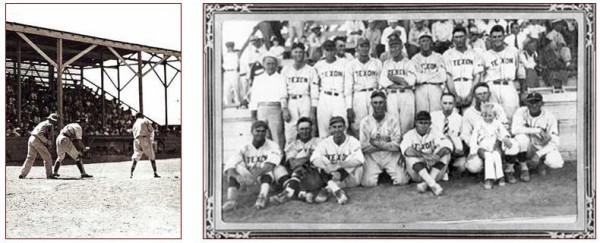
The first oil “company town” in the Permian Basin, Texon, was founded in 1924 by Big Lake Oil Company. The Texon Oilers won Permian Basin League championships in 1933, 1934, 1935 and 1939. Texon remains a tourist attraction – as a ghost town.
Early Permian Basin discoveries created many boom towns, including Midland, which some would soon refer to as “Little Dallas.”
By 1924, Michael L. Benedum, a successful independent oilman from Pittsburgh, Pennsylvania, and other successful independent producers — wildcatters — formed the Big Lake Oil Company. The new company established Texon, the first oil company town in the Permian Basin. Texon residents fielded a company town baseball team.
Today a ghost town, Texon was considered a model oil community. It had a school, church, hospital, theater, golf course, swimming pool – and a semi-pro company baseball team.
According to the Texas State Historical Association, the Texon Oilers baseball team was the centerpiece of the employee recreation plan of Levi Smith, vice president and general manager of the Big Lake Oil Company. Smith organized the club after he founded the Reagan County town west of Big Lake.
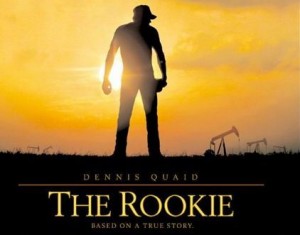
The Permian Basin oilfield was featured in a 2002 movie featuring a high school teacher and baseball coach. Image from Walt Disney Pictures poster.
By the summer of 1925 a baseball field was ready for use. In 1926 a 500-seat grandstand completed the facility. “In 1929 the Big Lake Oil Company began a tradition of hosting a Labor Day barbecue for employees and friends, highlighted by a baseball game,” noted historian Jane Spraggins Wilson.
“Management consistently attempted to schedule well-known clubs, such as the Fort Worth Cats and the Halliburton Oilers of Oklahoma,” added Wilson, who explained that during the Great Depression, “before good highways, television, and other diversions, the team was a source of community cohesiveness, entertainment, and pride.”
After the World War II, with its famous the oilfield diminishing and the town losing population, aging Oilers left the game for good, Wilson reports. By the mid-1950s the Texon Oilers company town baseball team were but a memory.
Hollywood visits Oilfields
The 2002 movie “The Rookie” — filmed almost entirely in the Permian Basin of West Texas — featured a Reagan County High School teacher. Based on the “true life” of baseball pitcher Jimmy Morris, it tells the story of baseball coach, Morris (played by Dennis Quaid), who despite being in his mid-30s briefly makes it to the major leagues.

The movie, promoted with the phrase, “It’s never too late to believe in your dreams,” begins with a flashback scene near Big Lake, the Santa Rita No. 1 drilling site.

At the beginning of the 2002 movie “The Rookie,” Catholic nuns christened the Santa Rita No. 1 cable-tool rig. In reality, one of the well’s owners climbed the derrick and threw rose petals given to him by Catholic women investors.
As the well is being drilled, Catholic nuns are shown carrying a basket of rose pedals to christen it for the patron Saint of the Impossible – Santa Rita. “Much is made of the almost mythic importance of oil in Big Lake, with talk of the Santa Rita oil well,” explained ESPN in the The Rookie in Reel Life.
Learn more about the Permian Basin by visiting the Petroleum Museum in Midland.
Company Town Baseball: Oilmen of Whiting, Indiana
In 1889, the Standard Oil Company began construction on its massive, 235-acre refinery in Whiting, Indiana. Today owned by BP, the Whiting refinery is the largest in the United States.
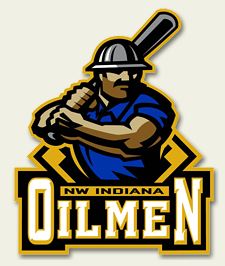
Whiting has been home to the North-west Indiana Oilmen since 2012.
In 2012, Whiting fielded a baseball team. On June 3, the Northwest Indiana Oilmen crushed the Southland Vikings 14-3 at Oil City Stadium in Standard Diamonds Park for the first win in franchise history. The Oilmen team became one of eight in the Midwest Collegiate League, a pre-minor baseball league.
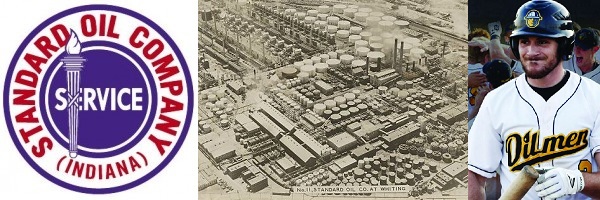
Standard Oil’s giant refinery in Whiting, Indiana, processed “sour crude” in the early 1900s. Now owned by BP, it is the largest U.S. refinery. The city of Whiting incorporated in 1903.
“The name Oil City Stadium celebrates Whiting’s history as a refinery town tucked away in the Northwest corner of Indiana for over 120 years,” noted team owner Don Popravak about the oil company town baseball. “The BP Refinery, located just beyond they outfield fence is a constant reminder of the blue collar attitude Whiting was built on,” he added.
CITGO and Oil History
With the arrival of baseball’s opening day in 2024, David Krell published a book about the Boston Red Sox and the role of the former Cities Service Company — CITGO — red triangle sign at Fenway Park. While researching The Fenway Effect: A Cultural History of the Boston Red Sox, Krell discovered the extensive history behind the company and its sign at Fenway, the team’s home ballpark since 1912.
_______________________
Recommended Reading: Textile League Baseball: South Carolina’s Mill Teams, 1880-1955 (2004); The Fenway Effect: A Cultural History of the Boston Red Sox (2024). Your Amazon purchase benefits the American Oil & Gas Historical Society. As an Amazon Associate, AOGHS earns a commission from qualifying purchases.
(2004); The Fenway Effect: A Cultural History of the Boston Red Sox (2024). Your Amazon purchase benefits the American Oil & Gas Historical Society. As an Amazon Associate, AOGHS earns a commission from qualifying purchases.
_______________________
The American Oil & Gas Historical Society (AOGHS) preserves U.S. petroleum history. Become an AOGHS annual supporting member and help maintain this energy education website and expand historical research. For more information, contact bawells@aoghs.org. © 2023 Bruce A. Wells.
Citation Information – Article Title: “Oilfields of Dreams – Gassers, Oilers, and Drillers Baseball.” Authors: B.A. Wells and K.L. Wells. Website Name: American Oil & Gas Historical Society. URL: https://aoghs.org/petroleum-art/oil-town-baseball. Last Updated: May 4, 2024. Original Published Date: September 1, 2007.
by Bruce Wells | Oct 18, 2023 | Petroleum Art
1950s advertising character became a petroleum industry award and monument in Texas parks.
Joe Roughneck’s rugged, square-jawed mug first appeared as the advertising face of a tubular goods manufacturer. Joe’s bronze bust soon became a petroleum industry award annually handed to executives, “whose accomplishments and character represent the highest ideals of the oil and natural gas industry.”
The drilling pipe manufacturer’s “Chief Roughneck Award,” first awarded in 1955, added the Joe Roughneck bust thanks to artist Torg Thompson and the Lone Star Steel Company, now the U.S. Steel Tubular Products, a subsidiary of United States Steel Corporation.
Originally featured in newspaper and magazine ads, a bust of Joe Roughneck’s bandaged visage would be dedicated in Texas parks.
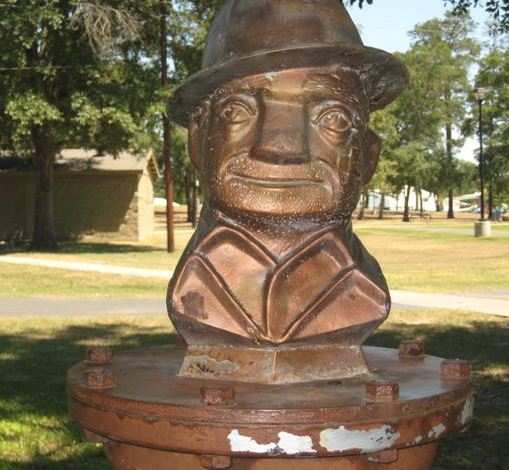
Texas artist Torg Thompson in the 1950s drew printed versions and and later sculpted the oilfield character “Joe Roughneck,” seen here in a Texas park.
Presented every fall at meetings of a national oil and gas industry trade association, Joe’s Chief Roughneck statue symbolizes the “leadership and integrity of individuals who have made a lasting impression on the energy industry.” Learn more in Chief Roughneck Award Winners.
The tough-looking oilfield character’s battered and bandaged face became popular and it was soon adopted by oilfield rig workers, prompting the company to proclaim, “Joe doesn’t belong to us anymore. He’s as universal as a rotary rig.”

Joe began his career on the scratch pad of Thompson, best known for his 124-by-20-foot mural, “Miracle at Pentecost,” at the Biblical Arts Center in Dallas The mural was destroyed by fire in 2005.
For Lone Star Steel Company ads, Thompson portrayed Joe with the rugged countenance of a man who had spent long hours working in oilfields.
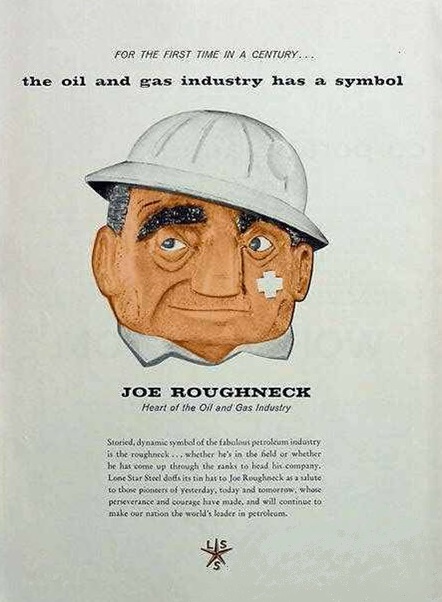
In 1959, Lone Star Steel Company, an oil field tubular goods manufacturer, produced this magazine advertisement featuring Joe Roughneck, the “Heart of the Oil and Gas Industry.”
“Joe’s jaw was squarely set to denote determination, his nose flattened as a souvenir of the rollicking life of a boom town. His eyes indicate the kindness and generosity of his breed. His mouth wore the trace of a smile, but there was a quizzical expression of one who had to see to believe,” notes a small museum in the heart of the East Texas oilfield.
“When the completed picture came into being on canvas, there was no doubt Joe was the heart of the oil patch,” the Depot Museum in Henderson adds.

Joe has been saluted by two Governors of Texas, named “Man of the Month” by a popular magazine, and has been the subject of countless newspaper articles, along with many radio and television commentaries. Joe also became the mascot of the White Oak Roughnecks, a high school football team of another East Texas oilfield community.
“Joe’s likeness has adorned the world’s largest golf trophy and once decorated an international oil exposition,” the Depot Museum concludes.
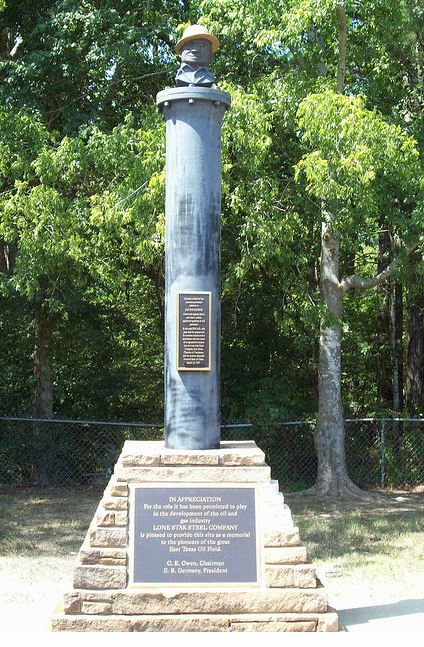
At the Gaston Museum in Joinerville, Texas, a Joe Roughneck memorial was dedicated “to the pioneers of the Great East Texas oilfield.” The October 1930, discovery well is just 1.75 miles away — and still producing for the Hunt Oil Company.
Joe still serves as a symbol for petroleum clubs that “recognize the pioneers of yesterday and today whose perseverance and courage made our nation the world’s leader in petroleum.”
Presented at the annual meeting of the Independent Petroleum Association of America, Joe’s head now sits atop oilfield monuments in Texas: Joinerville (1957), Conroe (1957), Boonsville (1970), and Kilgore (1986) – where he greets visitors to the East Texas Oil Museum.
Joe Roughneck in Joinerville
This, the first Joe Roughneck monument, was erected in Pioneer Park at the Gaston Museum in Joinerville, seven miles west of Henderson. The monument includes a time capsule sealed at the dedication on March 17, 1957, and to be opened in 2056. The capsule reportedly will tell future generations about the East Texas oilfield discovered by Columbus Marion “Dad” Joiner in early October 1930.

Joiner’s Daisy Bradford No. 3, discovery well for this prolific field, is nearby – less than two miles from the Gaston Museum. Production from the East Texas field exceeded five billion barrels of oil by 1993. Stripper wells still produce from the field.
Joe Roughneck in Conroe
In Conroe, about 40 miles north of Houston, Joe Roughneck rests on a monument in Candy Cane Park at the Heritage Museum of Montgomery County. He commemorates the discovery of a 19,000-acre field by George Strake in 1931 – “and others who envisioned an empire, dared to seek it, and discovered the Conroe oilfield.”

The Joe Roughneck monument in Conroe, Texas, is next to a miniature derrick protected by Plexiglas — and information about Montgomery County, where “whispers of oil discovery started in the early 1900s.”
The monument recognizes the completion of Strake’s Conroe oil field discovery well in June of 1932. The “Conroe Courier” headlines proclaimed, “Strake Well Comes In. Good for 10,000 Barrels Per Day.”
The Conroe oilfield led to major technology developments after Strake found the oil sands to be natural gas-charged, shallow – and dangerously unstable. By 1993, the 17.000-acre Conroe oilfield will have produced more than 717 million barrels of oil. Read the historical society article Technology and the Conroe Crater.
Joe Roughneck in Boonsville
Governor Preston Smith dedicated Boonsville’s Joe Roughneck on October 26, 1970 – the 20th anniversary of the Boonsville natural gas field discovery.
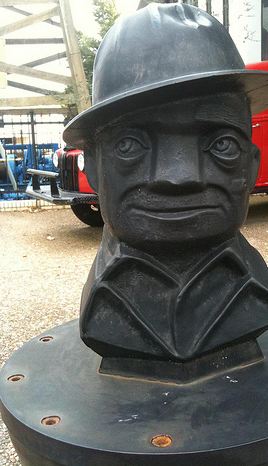
Joe Roughneck at the East Texas Oil Museum, which opened in 1980 in Kilgore.
The field’s 1945 discovery well, Lone Star Gas Company’s B. P. Vaught No. 1, produced 2.5 billion cubic feet of natural gas in its first 20 years. By 2001, the field – located in the Fort Worth Basin in North-Central Texas – had produced 3.1 trillion cubic feet of gas and 17 million barrels of condensate from 3,500 wells in the field.

Boonsville’s Joe Roughneck statue can be found on Farm to Market Road 920 about 13 miles southwest of Bridgeport in southwestern Wise County.
Joe Roughneck in Kilgore
Kilgore hosts a Joe Roughneck erected on March 2, 1986, in Sesquicentennial Plaza, celebrating the “boomers” who settled in Kilgore during the 1930s. Unfortunately, when Kilgore’s monument committee first approached Lone Star Steel, it learned that the Joe Roughneck cast had been destroyed in a fire. Lone Star let Kilgore use the original mold to produce this monument.
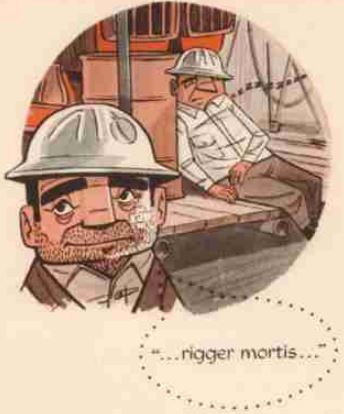
Detail from a 1957 “Joe Roughneck” Lone Star Steel advertisement.
During the East Texas boom, Kilgore had the densest number of wells in the world. Today’s World’s Richest Acre Park displays a pumping unit and the city has restored dozens of derricks from Kilgore’s boomtown birth – a story told at the East Texas Oil Museum.
As the Depot Museum concludes, Joe Roughneck remains rough and tough, sage and salty, capable and reliable, shrewd but honest. “Joe has throughout his lifetime symbolized the determination of the American petroleum industry, reaffirming the indomitable spirit of Chief Roughnecks the world over, past, present and future.”
View all Chief Roughneck Award Winners since 1955.
Finally, Joe Roughneck’s advertisement creation should also credit former Lone Star Steel Vice President L.D. “Red” Webster, according to Michael Webb, spouse of Webster’s daughter Rebel Webster (1959-2021).

Webb emailed the American Oil & Gas Historical Society in October 2021 and explained he was categorizing unique artifacts and other historic items related to the career of his late wife’s father. The preserved materials, including “pins, awards, tchotchkes, papers, plaques photos of Red and an original plaster bust of Joe Roughneck,” deserve a museum home, Webb noted.
_______________________
Recommended Reading: A Wildcatter’s Trek: Love, Money and Oil (2016 by 1995 Chief Roughneck Gene Ames Jr.); Trek of the Oil Finders: A History of Exploration for Petroleum (1975). Your Amazon purchase benefits the American Oil & Gas Historical Society. As an Amazon Associate, AOGHS earns a commission from qualifying purchases.
_______________________
The American Oil & Gas Historical Society (AOGHS) preserves U.S. petroleum history. Become an AOGHS annual supporting member and help maintain this energy education website and expand historical research. For more information, contact bawells@aoghs.org. Copyright © 2023 Bruce A. Wells. All rights reserved.
Citation Information: Article Title: “Meet Joe Roughneck.” Authors: B.A. Wells and K.L. Wells, Website Name: American Oil & Gas Historical Society. URL: https://aoghs.org/petroleum-art/joe-roughneck. Last Updated: October 19, 2023. Original Published Date: March 11, 2005.
by Bruce Wells | Aug 18, 2023 | Petroleum Art
Petroleum commemorated with 120 million stamps in 1959.
A centennial oil stamp commemorating the birth of the U.S. petroleum industry was issued on August 27, 1959, by Postmaster General Arthur Summerfield, who proclaimed: “The American people have great reason to be indebted to this industry. It has supplied most of the power that has made the American standard of living possible.”
As the sesquicentennial of the first U.S. well drilled to produce oil approached in 2009, a special committee sought U.S. Postal Service approval for a commemorative stamp. The committee and petroleum historians twice petitioned for a special stamp similar to one issued for the petroleum industry’s 1959 centennial of America’s first oil well. (more…)
by Bruce Wells | Aug 1, 2023 | Petroleum Art
Caveman cartoonist Victor Hamlin once worked as an oilfield cartographer in Permian Basin.
The widely popular Depression Era newspaper comic strip character Alley Oop began in the imagination of a young Texas cartographer who drew Permian Basin oilfield maps.
The club-wielding Alley Oop caveman appeared for the first time in the summer of 1933 when Victor Hamlin, a former Ft. Worth Star-Telegram reporter, published fanciful tales about the Stone Age Kingdom of Moo. Hamlin began syndicating his daily cartoon in the Des Moines Register in Iowa.
(more…)
by Bruce Wells | Jul 1, 2023 | Petroleum Art
Did L. Frank Baum’s 1880s “Castorine” oil inspire the Tin Man?
The Tin Man’s oil can in The Wonderful Wizard of Oz perhaps can trace its roots to America’s earliest oilfields — where L. Frank Baum founded a lubricant business before becoming the famous children’s book author.
“Sometimes, when researching history, you find places where it’s still alive,” explained Evan Schwartz in his 2009 book, Finding Oz: How L. Frank Baum Discovered the Great American Story.

Before publishing his children’s book in 1900, L. Frank Baum sold a popular axle oil from a company he founded in Syracuse, New York.
Schwartz’s search for the oil can of the Tin Woodman led him to discovering that in the 1880s, L. Frank Baum and his brother started an petroleum products business in Syracuse, New York. The Baum’s Castorine business continues to this day.

The future author of the children’s novel The Wonderful Wizard of Oz once sold cans of buggy wheel and axle oils for a living.

L. Frank Baum — whose father found success in Pennsylvania oilfields — served as chief salesman for Baum’s Castorine Company, which he founded with his brother on July 9, 1883.
In 1883, Baum and his brother Benjamin launched their business venture offering lubricants, oils, greases — and “Baum’s Castorine, the great axle oil.”
Reporting on the July 9, 1883, opening, the Syracuse Daily Courier newspaper noted that Baum’s Castorine was a rust-resistant axle grease concoction for machinery, buggies, and wagons. The grease was advertised to be “so smooth it makes the horses laugh.”
Baum’s Castorine Company prospered with Frank serving as superintendent and chief sales representative for the next four years. The upstate New York business was less than 300 miles from Titusville, Pennsylvania, where first U.S. oil well had been drilled in 1859.
Tin Woodman
As the 20th century approached, L. Frank Baum spent much of his time visiting small towns to marketing the brothers’ oil products, according to a 2011 exhibit at the Kalamazoo Valley Museum in Michigan. The exhibit also noted, “On one of these trips, while installing a window display for a customer, the idea of the Tin Woodman came to him.”
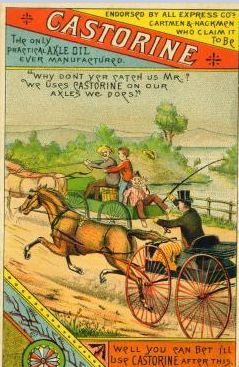
L. Frank Baum’s sales trips may have influenced Oz. “On one of these trips, while installing a window display for a customer, the idea of the Tin Woodman came to him.”
The former exhibit at the Kalamazoo Valley Museum also explained that although Baum petroleum lubricating products enjoyed some success, the original business, “came to an end when the bookkeeper gambled away the profits.”
Baum wrote of his Baum’s Castorine Company, “I see no future in it to warrant my wasting any more years of my life in trying to boom it.”
The frustrated businessman sold the business, which by 1879 had new owners — and still doing business as Baum’s Castorine Company. In May 1900, the former oil products businessman published the first of his 14 Oz children’s books, The Wonderful Wizard of Oz, which was followed by The Marvelous Land of Oz four years later.
Petroleum Producer’s Son
L. (Lyman) Frank Baum was born in Chittenango, New York, on May 15, 1856, the seventh of nine children of Cynthia Stanton and Benjamin Ward Baum — one of only five of the children to survive into adulthood.
Thanks to Benjamin Ward Baum’s financial success in the newly born Pennsylvania petroleum industry, the young Baum grew up in an environment where his imagination and love of reading flourished.

Baum’s Castorine products “are designed to extend machine life and reduce your maintenance costs.”
In 1860, just one year after America’s first commercial oil discovery, Benjamin Ward Baum closed the family barrel-making business to risk his fortunes in the western Pennsylvania oilfields. “Frankie” was then only four and a half years old. Productive oil wells drilled near Titusville and Cherry Tree Run would bring his enterprising father great wealth.
and Cherry Tree Run would bring his enterprising father great wealth.
“Benjamin recognized a splendid opportunity and joined the crowds who moved in to exploit the oilfields and develop the area. A hundred new wells were drilled every month, ingenious mechanical contrivances were invented, towns and cities were built,” wrote Katharine M. Rogers in her 2002 book L. Frank Baum, Creator of Oz: A Biography .
.

“Benjamin began acquiring oilfields, including a particularly profitable one at Cherry Tree Run, a few miles south of Titusville,” Rogers reported. “He later bought property between Bradford, Pennsylvania, and Olean, New York, where he helped to develop the hamlet of Gilmour and built a hotel and an opera house.”
As U.S. consumer demand for kerosene lamps skyrocketed, Pennsylvania’s oil region produced the new industry’s earliest tycoons, long before Standard Oil Company (also see the cautionary tale of the Legend of “Coal Oil Johnny”).
By 1862, the elder Baum owned Carbon Oil Company and was a well-established independent oil producer. His success helped finance diversification into dry goods and other mercantile businesses. Son Frank found employment in several of these family ventures as a young man.
When his father purchased the Cynthia Oil Works in Bolivar, New York, Frank operated a retail outlet for awhile.
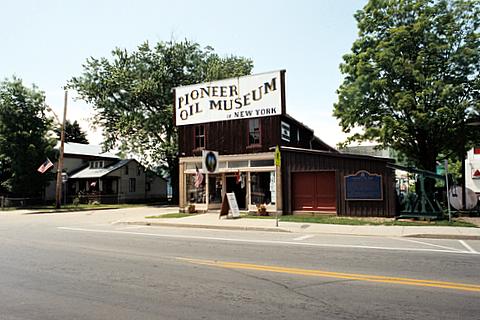
L. Frank Baum’s father once owned an oil company in Bolivar, New York, where a museum today exhibits the region’s extensive petroleum history. Photo by Bruce Wells.
“The Cynthia Oil Works, the first refinery in Bolivar Township, was erected on the Porter Cowles flats at the north end of Bolivar village in 1882,” according to historian Ronald G. Taylor.
“The plant, owned by B.W. Baum & Son, dealers in oil leases and managers of the first opera house at Richburg, was designed as a lubricating oil works and for the manufacture of ship oil of 300 fire test for illuminating on board ships,” Taylor explained.
Although there were nine daily and 18 weekly newspapers published in the oil regions, there no longer was unlimited free enterprise in oilfields. “John D. Rockefeller had moved in and was increasingly controlling distribution,” added Rogers in her book.
“In 1878, Benjamin organized a group of independent producers to break Rockefeller’s grip by building a pipeline from Bradford to Rochester, where the oil could be transferred to tank cars and shipped to refineries in New York and Buffalo.”

Rockefeller’s Standard Oil Company used its influence with the New York Central Railroad and the state legislature to block the planned pipeline. Despite the setback, Baum continued to find success with prolific oil wells in New York.
After almost 30 years in the oil business, Benjamin Ward Baum (1821-1887) died in Syracuse, New York. His petroleum wealth had helped him acquire small theaters in New York and Pennsylvania and permitted his son to pursue writing, publishing journals, and writing for the stage — perhaps setting the stage for Frank’s future fame.
Finding Tin Man’s Oil Can
When historian Evan L. Schwartz researched his 2009 book, Finding Oz: How L. Frank Baum Discovered the Great American Story, he was surprised to learn of the role petroleum played in Baum’s life — and that the Tin Woodman’s oil can trace its roots to Baum’s Castorine Company.

L. Frank Baum sold his Baum’s Castorine Company in 1888. His many Castorine sales trips may have led to the idea of a Tin Woodman character for his book, illustrated by W.W. Denslow.
“L. Frank Baum sold cans of buggy wheel oil for a living as the co-owner of Baum’s Castorine Company of Syracuse, New York,” Schwartz explained, noting the company’s troubles that led to Baum’s selling it in 1888. Schwartz also discovered the company still manufactured industrial oils and lubricants under the brand name, Baum’s Castorine Company.
“So I visited the current location in Rome, New York, and sat down for a peek into the archives with owner Charles Mowry, whose grandfather was one of the investors who bought the company from Frank Baum himself,” Schwartz wrote.
“The smells of fine lubricant wafted in the air as I perused the collection of historic oil cans and heard the legend of Baum’s magic balms,” he noted.
“What if Frank had never sold oil cans? Would we have never met the heartless Tin Man? And in 1939, why wasn’t Baum’s Castorine given the chance to pony up for some choice product placement?”
Learn about the historic Allegheny petroleum industry by visiting the Pioneer Oil Museum of New York in Bolivar.

_______________________
Recommended Reading: Finding Oz: How L. Frank Baum Discovered the Great American Story (2009); L. Frank Baum, Creator of Oz: A Biography
(2009); L. Frank Baum, Creator of Oz: A Biography (2002); Empire Oil: The Story of Oil in New York State (1949). Your Amazon purchase benefits the American Oil & Gas Historical Society. As an Amazon Associate, AOGHS earns a commission from qualifying purchases.
(2002); Empire Oil: The Story of Oil in New York State (1949). Your Amazon purchase benefits the American Oil & Gas Historical Society. As an Amazon Associate, AOGHS earns a commission from qualifying purchases.
_______________________
The American Oil & Gas Historical Society (AOGHS) preserves U.S. petroleum history. Become an AOGHS annual supporting member and help maintain this energy education website and expand historical research. For more information, contact bawells@aoghs.org. © 2023 Bruce A. Wells. All rights reserved.
Citation Information – Article Title: “Oil in the Land of Oz.” Authors: B.A. Wells and K.L. Wells. Website Name: American Oil & Gas Historical Society. URL: https://aoghs.org/petroleum-art/l-frank-baum-castorine-oil. Last Updated: July 1, 2023. Original Published Date: June 1, 2005.


























